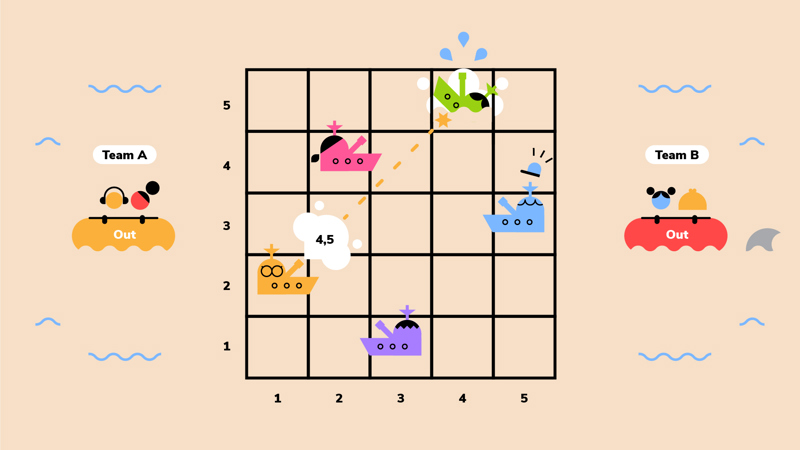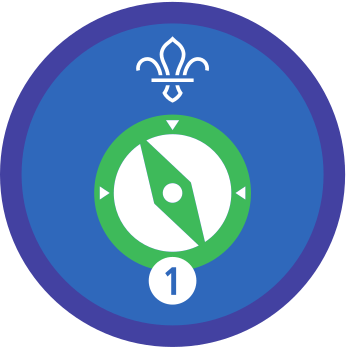
Human battleships
You’ll need
- Pens or pencils
- A4 paper
- Something to mark lines (for example, chalk, masking tape, or rope)
- A sheet or screen
Before you begin
- Use the masking tape or chalk to make two identical grids on the floor next to each other. They should be five squares by five squares, and each square should be big enough for someone to stand in.
- Label the vertical lines at the bottom of each grid with numbers, increasing from left to right. You can use chalk to write on the floor, or pens and paper to make signs.
- Label the horizontal lines at the left-hand side of each grid with numbers, increasing from bottom to top.
- Make a screen between the grids. You could string a line of rope between them and hang a sheet across it, attach fabric between two flag poles, or use a free-standing clothes rail.
Chat about grid references
- The person leading the game should ask everyone what they already know about four digit grid references.
- The person leading the game should explain how grid references work. Everyone should listen carefully, as they’ll need to use grid references to save their ships.
-
- Maps usually have horizontal and vertical lines, which divide them into squares. The grids have these lines, too.
- Just like on a map, the lines on the grid are numbered. These numbers let us name the squares.
- The numbers which run horizontally along the bottom of the square go from left to right (west to east) so are called eastings.
- The numbers which run vertically up the side of the square go from bottom to top (south to north) so are called northings.
- To find the grid reference of a square, you give the numbers of the lines that meet in the bottom left corner.
- The easting always comes before the northing in a grid reference. You can remember this if you know that you go ‘along the corridor, and then up the stairs’.
- This is a four figure grid reference, because it’s made up of four digits (two for the easting and two for the northing).
Play human battleships
- Split into two teams.
- One team should stand on each grid. Each player should stand inside one square. Each team should position themselves randomly across their grid.
- One player from the first team should call out a grid reference.
- If anyone from the opposite team is in that square, they should call out ‘you’ve sunk my battleship’. They’re now out of the game – they should go to the side and watch.
- Repeat steps three and four with the other team calling out the grid reference.
- Keep repeating steps three and four, with teams taking it in turns to call the grid references. They should try to remember which references have already been said, to avoid ‘wasting’ a turn on a square they know is empty.
- The game ends when all a team’s battleships have been sunk and all of their players are out. The team with battleships left is the winner.
Reflection
This game needed you to be a team player. How did you all work together to reach your goal? Did you have different roles? How did you speak to each other? Was it tricky not to say anything that gave things away (for example, not saying ‘that was close!’)? How did you help your teammates? Were you kind if someone made a mistake?
This game also needed you to persevere. Was it tricky to keep going if you kept guessing empty squares? Was it hard to keep going when other members of your team got caught? How did your team encourage each other to keep going? Was it hard to stay focused, and remember the references your team had already guessed? What helped you stay focussed on the game?
Safety
All activities must be safely managed. You must complete a thorough risk assessment and take appropriate steps to reduce risk. Use the safety checklist to help you plan and risk assess your activity. Always get approval for the activity, and have suitable supervision and an InTouch process.
You can have as many squares as you want. It can be bigger or smaller than five by five, but it should still be a square. Why not try four by four, or six by six?
People could play in pairs. Both of the people in a square are out if the other team name the square. This may make the game go faster. You’ll probably need to make the squares a bit bigger if you want to give this a go.
Make sure the squares are big enough for everyone, including anyone who needs some extra room, for example, because they have a mobility aid or need someone else in the square with them.
Anyone who wants to can buddy up, and stand in a square as a pair. Teams can help each other to name grid references, and know if they’re out, as it’s OK if some people find it tricky.
All Scout activities should be inclusive and accessible.
You could also use this game to learn more about map symbols while practising your grid references before you play. Print out some symbols, and place them randomly in the grid. Shout out the name of a symbol, and see if people can find its grid reference. You could also practice compass directions. Shout out the name of two symbols, and see if people can find out the compass direction of the first to the second. This game could then be used to work towards requirement two or six of stage two of the Navigator Staged Activity Badge.

